Business Structures: Pros and Cons

Hi, I’m Scott Trevethan from Scott Partners here in Melbourne. Today, I want to talk to you about something that every small and medium sized enterprise faces: choosing the right structure for their business.
What we’re going to do today is go through the most common business structures in Australia, and some of the pros and cons of each. The three structures are: sole trader, partnership and company.
A sole trader is by far the simplest business structure. This simplicity is also its biggest strength. Sole traders have a very low level of separate legal or tax requirements, which is the reason it is a popular way to start a business.
A gardener, let’s call him Dave, who offers his services to local homeowners, who trades on his own, and controls and manages his own business, is a good example.
All of the income that Dave the gardener generates from his business is treated as individual income. That means he includes all business income on his personal tax return.
A disadvantage of being a sole trader is that you can be personally liable for anything that goes wrong in connection with your goods or services. There is no way to limit this risk as a sole trader, and your personal assets can be at risk.
Partnerships
A partnership is another common business structure.
A partnership is not a legal entity on its own….. it can help to think of a partnership as two or more sole traders operating together for mutual benefit to do something they couldn’t do alone, much like the players in an AFL team.
Partnerships are governed by the rules set out in their partnership deed, which is essentially a contract between the partners.
Each of the partners pays tax on their share of partnership income on their personal tax returns.
Partnerships can also apply for an Australian Business Number (ABN) to make meeting some government requirements simpler.
A disadvantage of partnerships is that they are not permanent, and must be dissolved and reconstituted if one partner leaves. The assets of the partners can also be at risk in a partnership.
A Company
Of the three business structures we are looking at today, a company is the most complex and expensive to set up. The costs include formal registration, and the reporting for companies is generally stricter than it is for either sole traders or partnerships, including the need to lodge a separate company tax return.
The advantages of running a business as a company includes a company tax rate of 30%, compared to higher rates for a sole trader or partner who earns more than a nominated amount of income.
Companies are also entitled to specific company tax deductions, offsets and rebates designed to encourage business growth. Companies are also “limited liability” meaning that the personal assets of the owners or managers are protected.
To speak more about which company structure is right for you and your business now, or in the future, just give us a call on [insert phone number here]. We can arrange an appointment and advise you on how to grow your business.
Thanks for watching, I’m Scott Trevethan and until next time, bye for now.





